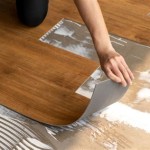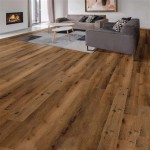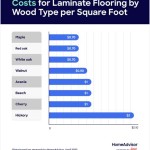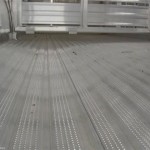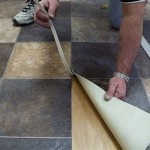Is Cherry Wood Good For Flooring In Kitchens?
Selecting the right flooring for a kitchen is a significant decision, impacting both the aesthetics and functionality of the space. The kitchen, often considered the heart of the home, experiences heavy foot traffic, spills, and temperature fluctuations. Therefore, the flooring material must be durable, easy to maintain, and visually appealing. Cherry wood, prized for its rich color and smooth grain, is often considered for flooring projects. However, its suitability for kitchen applications warrants careful consideration. This article will delve into the properties of cherry wood, explore its advantages and disadvantages as a kitchen flooring material, and examine factors that influence its long-term performance in this demanding environment.
Cherry wood, derived from the American Black Cherry tree (Prunus serotina), is a hardwood known for its distinctive characteristics. Its heartwood ranges in color from a light reddish-brown to a deep, rich reddish hue, often deepening with age and exposure to light. The sapwood, the outer layer of the tree, is typically a paler yellowish-white. Cherry wood possesses a fine, uniform grain with occasional knots and gum pockets, contributing to its unique character. It is relatively easy to work with, accepting stains and finishes well. These properties render it a popular choice for furniture, cabinetry, and flooring.
When evaluating cherry wood for kitchen flooring, several factors must be taken into account. These include its hardness, stability, moisture resistance, maintenance requirements, and overall cost. Each of these aspects contributes to the overall suitability of cherry wood as a flooring option in a kitchen environment. A comprehensive understanding of these properties is essential for making an informed decision.
Hardness and Durability of Cherry Wood Flooring
The Janka hardness scale measures the resistance of wood to indentation and wear. Cherry wood typically scores around 950 on the Janka scale. While this is considered moderately durable, it is softer compared to other popular hardwood flooring options like oak (around 1290) or maple (around 1450). This means that cherry wood is more susceptible to dents, scratches, and other surface damage from everyday use in a high-traffic area such as a kitchen. Dropped pots and pans, pet claws, and furniture movement can all contribute to wear and tear. To mitigate this risk, a durable finish and careful maintenance are crucial. Area rugs strategically placed in high-traffic zones can also offer additional protection. Selecting a thicker plank of cherry wood can also slightly improve its resistance to wear.
The durability of cherry wood flooring can be enhanced through the application of a high-quality finish. Polyurethane finishes, specifically water-based polyurethanes, offer excellent protection against scratches and moisture. Multiple coats of finish are recommended to provide a robust barrier. Regular refinishing may be required over time to maintain the flooring's appearance and protect the wood from further damage. The frequency of refinishing will depend on the level of traffic and the care taken to maintain the floor. A proactive approach to maintenance is essential for preserving the beauty and integrity of cherry wood flooring in a kitchen.
Stability and Moisture Resistance of Cherry Wood Flooring
Wood's stability refers to its ability to resist warping, swelling, and shrinking in response to changes in humidity and temperature. Cherry wood is considered moderately stable. However, kitchens are often subject to fluctuations in temperature and humidity due to cooking, dishwashing, and general activity. Excessive moisture can cause the wood to expand, leading to gaps between planks and potential warping. Conversely, dry air can cause the wood to shrink, resulting in cracks. Proper installation is critical to minimize these issues. Acclimatizing the wood to the kitchen environment before installation allows it to adjust to the typical temperature and humidity levels. A vapor barrier beneath the flooring can also help to prevent moisture from seeping up from the subfloor.
Moreover, cherry wood is not naturally resistant to moisture. Spills should be cleaned up promptly to prevent water from penetrating the wood. Standing water can cause staining and damage to the finish. Regular cleaning with a damp mop is acceptable, but excessive water should be avoided. Investing in a dehumidifier during periods of high humidity can help to maintain a stable moisture level in the kitchen. In areas prone to frequent spills, such as around the sink or dishwasher, consider using floor mats or area rugs to protect the wood flooring. Preventing moisture damage is paramount in ensuring the longevity of cherry wood floors in a kitchen setting.
Maintenance and Cost Considerations for Cherry Wood Flooring
Maintaining cherry wood flooring in a kitchen requires regular care. Sweeping or vacuuming regularly removes dirt and debris that can scratch the finish. Using a microfiber mop with a wood floor cleaner specifically designed for hardwood floors is recommended for damp mopping. Avoid using harsh chemicals, abrasive cleaners, or excessive water, as these can damage the finish and the wood itself. Promptly cleaning up spills is crucial to prevent staining and water damage. Consider using felt pads under furniture legs to prevent scratches and dents. Regular maintenance is essential for preserving the beauty and extending the lifespan of cherry wood flooring.
The cost of cherry wood flooring is generally higher than that of other hardwood options like oak. The price reflects the wood's aesthetic appeal and the care required in its harvesting and processing. Installation costs can also be significant, particularly if professional installation is chosen. In addition to the initial cost of the flooring and installation, homeowners should factor in the cost of ongoing maintenance, including cleaning supplies and potential refinishing. While cherry wood flooring can enhance the aesthetic value of a kitchen, it represents a considerable investment. Carefully weigh the costs against the benefits before making a decision. Exploring alternative flooring options with similar aesthetics but greater durability may be a worthwhile consideration for budget-conscious homeowners.
Beyond the practical considerations, the aesthetic appeal of cherry wood is a significant factor for many homeowners. The rich color and smooth grain can add warmth and elegance to a kitchen. However, cherry wood is prone to darkening over time with exposure to light. This color change can be desirable for some, creating a richer and more mature look. However, it is important to be aware of this characteristic, especially when replacing or adding to existing cherry wood floors. Matching the color of new cherry wood to existing floors can be challenging due to the natural darkening process. Consider the long-term aesthetic impact and plan accordingly when selecting cherry wood for kitchen flooring.
In summary, cherry wood can be a visually appealing flooring option for kitchens, offering a touch of elegance and warmth. However, its relatively soft nature, susceptibility to moisture damage, and higher cost necessitate careful consideration. Homeowners should prioritize proper installation, diligent maintenance, and the use of protective finishes to maximize its longevity and minimize potential issues. While cherry wood may not be the most practical choice for all kitchens, with the right approach and consistent care, it can provide a beautiful and durable flooring solution.

The Benefits Of Cherry Wood Flooring David Tiftickjian Sons

Wide Plank Wood Flooring In The Kitchen Hull Blog

Cherry Wood Flooring The Choice For Home Elegance

Cherry Kitchen Floors Design Ideas

7 Cherry Kitchen Design Ideas That Give Your Home A New Look Decorcabinets Com

What Is The Best Hardwood Flooring For Kitchens And Why Impressions Collection

The Key Benefits Of Cherry Vs Oak Floors Carlisle Wide Plank

How To Choose Wood Flooring For A Kitchen Mi Hardwood Services Cameron The Sandman Contractor

Are Cherry Wood Cabinets Outdated All Coast Inspections

Brazilian Cherry Hardwood Floors Design Ideas
Related Posts



